2017 PEUGEOT 5008 oil change
[x] Cancel search: oil changePage 9 of 404
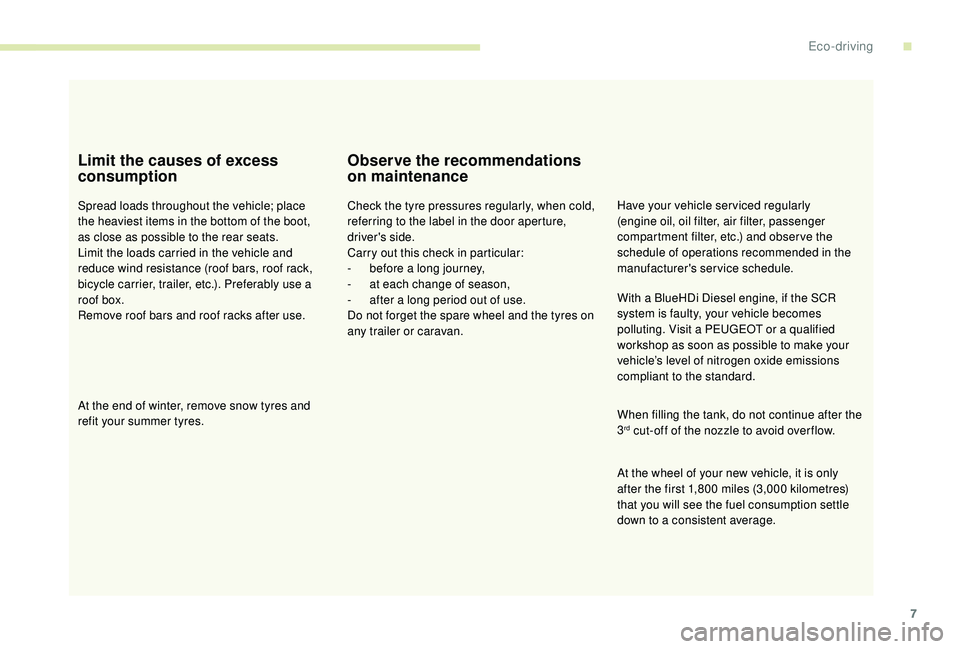
7
Limit the causes of excess
consumption
Spread loads throughout the vehicle; place
the heaviest items in the bottom of the boot,
as close as possible to the rear seats.
Limit the loads carried in the vehicle and
reduce wind resistance (roof bars, roof rack,
bicycle carrier, trailer, etc.). Preferably use a
roof box.
Remove roof bars and roof racks after use.
At the end of winter, remove snow tyres and
refit your summer tyres.
Observe the recommendations
on maintenance
Check the tyre pressures regularly, when cold,
referring to the label in the door aperture,
driver's side.
Carry out this check in particular:
-
b
efore a long journey,
-
a
t each change of season,
-
a
fter a long period out of use.
Do not forget the spare wheel and the tyres on
any trailer or caravan. Have your vehicle ser viced regularly
(engine oil, oil filter, air filter, passenger
compartment filter, etc.) and obser ve the
schedule of operations recommended in the
manufacturer's service schedule.
When filling the tank, do not continue after the
3
rd cut-off of the nozzle to avoid over flow.
At the wheel of your new vehicle, it is only
after the first 1,800
miles (3,000 kilometres)
that you will see the fuel consumption settle
down to a consistent average. With a BlueHDi Diesel engine, if the SCR
system is faulty, your vehicle becomes
polluting. Visit a PEUGEOT or a qualified
workshop as soon as possible to make your
vehicle’s level of nitrogen oxide emissions
compliant to the standard.
.
Eco-driving
Page 259 of 404
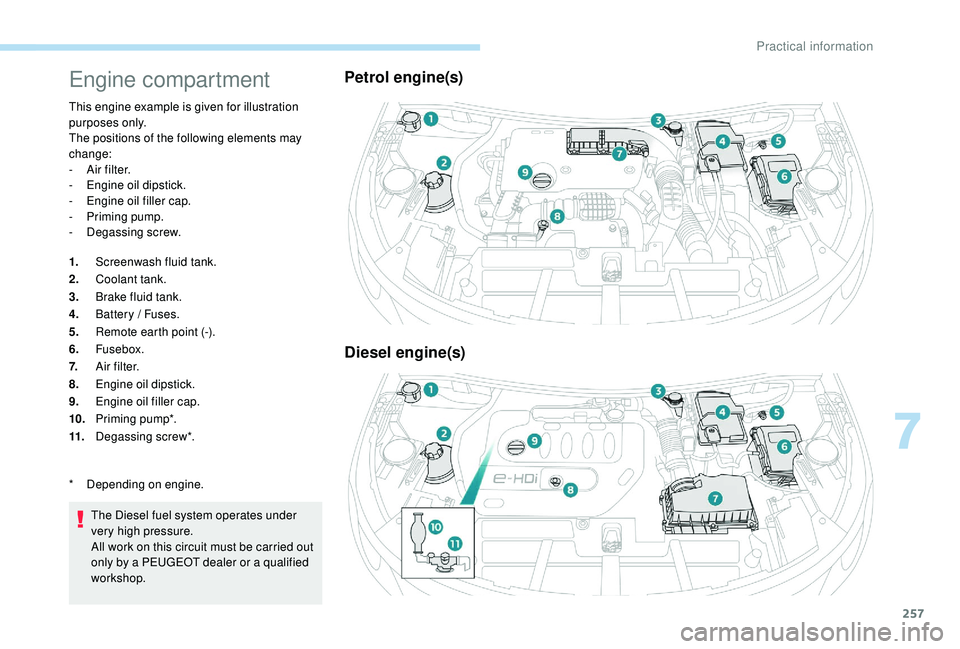
257
Engine compartment
This engine example is given for illustration
purposes only.
The positions of the following elements may
change:
-
A
ir filter.
-
E
ngine oil dipstick.
-
E
ngine oil filler cap.
-
P
riming pump.
-
D
egassing screw.
1. Screenwash fluid tank.
2. Coolant tank.
3. Brake fluid tank.
4. Battery / Fuses.
5. Remote earth point (-).
6. Fusebox.
7. A i r f i l t e r.
8. Engine oil dipstick.
9. Engine oil filler cap.
10. Priming pump*.
11. Degassing screw*.
The Diesel fuel system operates under
very high pressure.
All work on this circuit must be carried out
only by a PEUGEOT dealer or a qualified
workshop.
Petrol engine(s)
Diesel engine(s)
* Depending on engine.
7
Practical information
Page 260 of 404
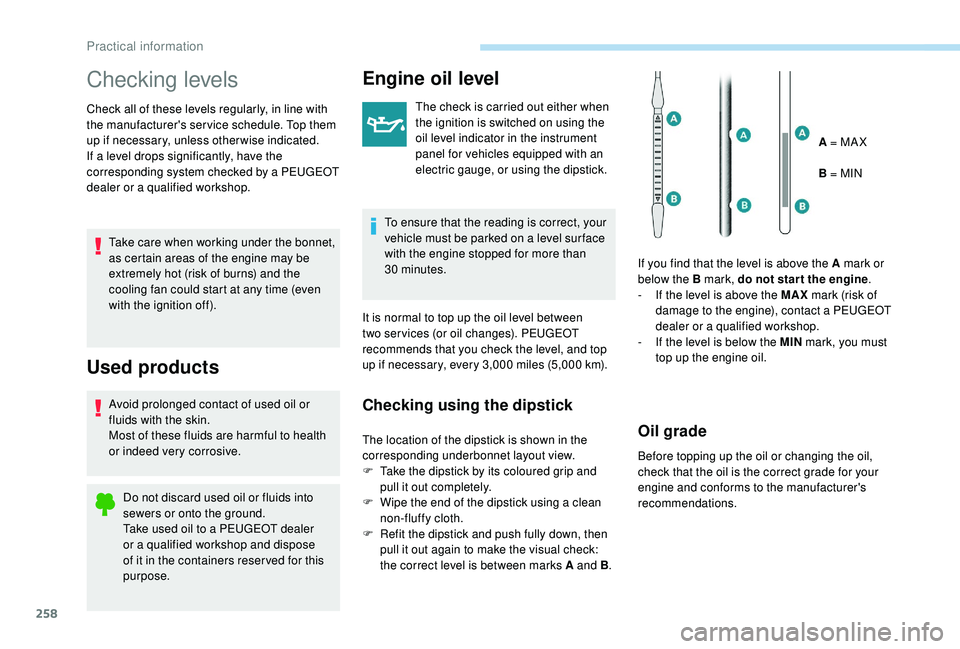
258
Checking levels
Check all of these levels regularly, in line with
the manufacturer's service schedule. Top them
up if necessary, unless other wise indicated.
If a level drops significantly, have the
corresponding system checked by a PEUGEOT
dealer or a qualified workshop.Take care when working under the bonnet,
as certain areas of the engine may be
extremely hot (risk of burns) and the
cooling fan could start at any time (even
with the ignition off).
Used products
Avoid prolonged contact of used oil or
fluids with the skin.
Most of these fluids are harmful to health
or indeed very corrosive.Do not discard used oil or fluids into
sewers or onto the ground.
Take used oil to a PEUGEOT dealer
or a qualified workshop and dispose
of it in the containers reser ved for this
purpose.
Engine oil level
The check is carried out either when
the ignition is switched on using the
oil level indicator in the instrument
panel for vehicles equipped with an
electric gauge, or using the dipstick.
To ensure that the reading is correct, your
vehicle must be parked on a level sur face
with the engine stopped for more than
30
minutes.
It is normal to top up the oil level between
two ser vices (or oil changes). PEUGEOT
recommends that you check the level, and top
up if necessary, every 3,000
miles (5,000 km).
Checking using the dipstick
The location of the dipstick is shown in the
corresponding underbonnet layout view.
F
T
ake the dipstick by its coloured grip and
pull it out completely.
F
W
ipe the end of the dipstick using a clean
non-fluffy cloth.
F
R
efit the dipstick and push fully down, then
pull it out again to make the visual check:
the correct level is between marks A and B .A = MA X
B = MIN
If you find that the level is above the A mark or
below the B mark, do not star t the engine .
-
I
f the level is above the MAX
mark (risk of
damage to the engine), contact a PEUGEOT
dealer or a qualified workshop.
-
I
f the level is below the MIN
mark, you must
top up the engine oil.Oil grade
Before topping up the oil or changing the oil,
check that the oil is the correct grade for your
engine and conforms to the manufacturer's
recommendations.
Practical information
Page 261 of 404
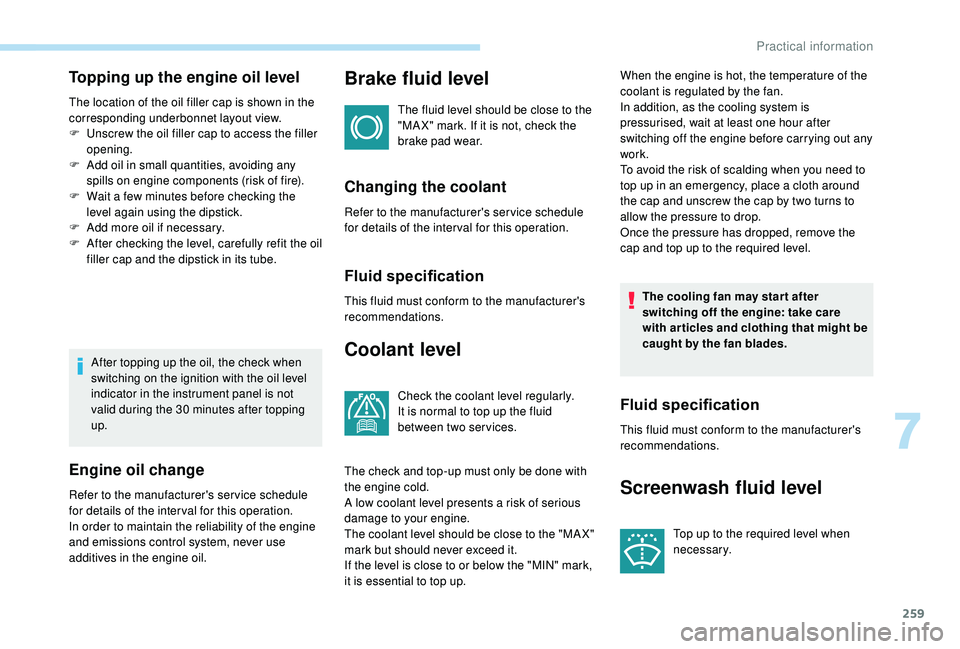
259
Topping up the engine oil level
The location of the oil filler cap is shown in the
corresponding underbonnet layout view.
F
U
nscrew the oil filler cap to access the filler
opening.
F
A
dd oil in small quantities, avoiding any
spills on engine components (risk of fire).
F
W
ait a few minutes before checking the
level again using the dipstick.
F
A
dd more oil if necessary.
F
A
fter checking the level, carefully refit the oil
filler cap and the dipstick in its tube.
After topping up the oil, the check when
switching on the ignition with the oil level
indicator in the instrument panel is not
valid during the 30
minutes after topping
up.
Engine oil change
Refer to the manufacturer's service schedule
for details of the inter val for this operation.
In order to maintain the reliability of the engine
and emissions control system, never use
additives in the engine oil.
Brake fluid level
The fluid level should be close to the
"MA X" mark. If it is not, check the
brake pad wear.
Changing the coolant
Refer to the manufacturer's service schedule
for details of the inter val for this operation.
Fluid specification
This fluid must conform to the manufacturer's
recommendations.
Coolant level
Check the coolant level regularly.
It is normal to top up the fluid
between two services.
The check and top-up must only be done with
the engine cold.
A low coolant level presents a risk of serious
damage to your engine.
The coolant level should be close to the "MA X"
mark but should never exceed it.
If the level is close to or below the "MIN" mark,
it is essential to top up. When the engine is hot, the temperature of the
coolant is regulated by the fan.
In addition, as the cooling system is
pressurised, wait at least one hour after
switching off the engine before carrying out any
work.
To avoid the risk of scalding when you need to
top up in an emergency, place a cloth around
the cap and unscrew the cap by two turns to
allow the pressure to drop.
Once the pressure has dropped, remove the
cap and top up to the required level.
The cooling fan may star t after
switching off the engine: take care
with articles and clothing that might be
caught by the fan blades.Fluid specification
This fluid must conform to the manufacturer's
recommendations.
Screenwash fluid level
Top up to the required level when
necessary.
7
Practical information
Page 263 of 404
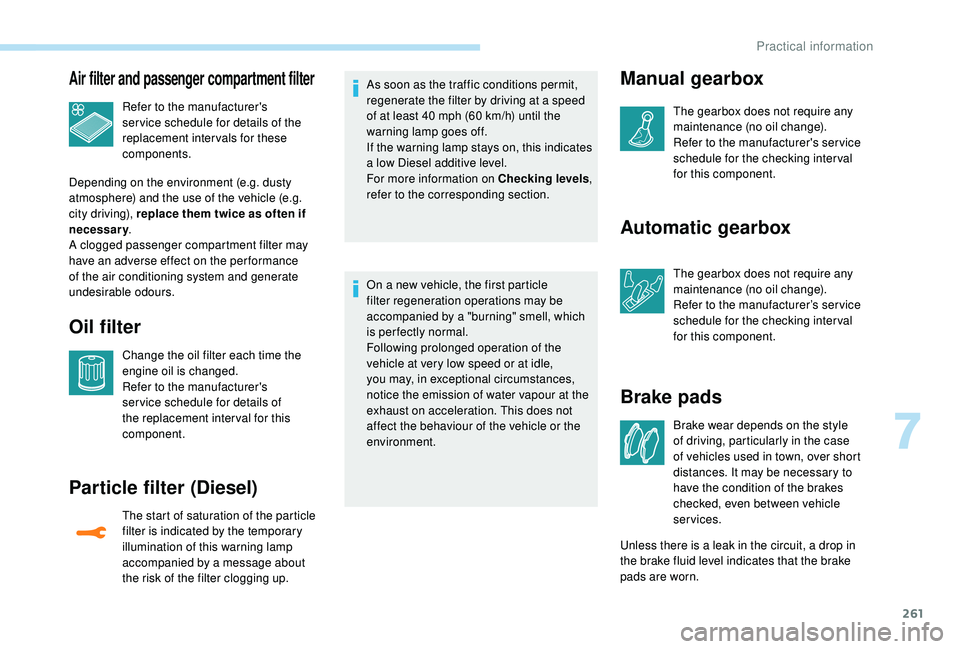
261
Air filter and passenger compartment filter
Refer to the manufacturer's
ser vice schedule for details of the
replacement intervals for these
components.
Depending on the environment (e.g. dusty
atmosphere) and the use of the vehicle (e.g.
city driving), replace them twice as often if
necessary .
A clogged passenger compartment filter may
have an adverse effect on the per formance
of the air conditioning system and generate
undesirable odours.
Oil filter
Change the oil filter each time the
engine oil is changed.
Refer to the manufacturer's
ser vice schedule for details of
the replacement inter val for this
component.
Particle filter (Diesel)
The start of saturation of the particle
filter is indicated by the temporary
illumination of this warning lamp
accompanied by a message about
the risk of the filter clogging up. As soon as the traffic conditions permit,
regenerate the filter by driving at a speed
of at least 40
mph (60 km/h) until the
warning lamp goes off.
If the warning lamp stays on, this indicates
a low Diesel additive level.
For more information on Checking levels ,
refer to the corresponding section.
On a new vehicle, the first particle
filter regeneration operations may be
accompanied by a "burning" smell, which
is per fectly normal.
Following prolonged operation of the
vehicle at very low speed or at idle,
you may, in exceptional circumstances,
notice the emission of water vapour at the
exhaust on acceleration. This does not
affect the behaviour of the vehicle or the
environment.
Manual gearbox
The gearbox does not require any
maintenance (no oil change).
Refer to the manufacturer's service
schedule for the checking inter val
for this component.
Automatic gearbox
The gearbox does not require any
maintenance (no oil change).
Refer to the manufacturer’s service
schedule for the checking inter val
for this component.
Brake pads
Brake wear depends on the style
of driving, particularly in the case
of vehicles used in town, over short
distances. It may be necessary to
have the condition of the brakes
checked, even between vehicle
services.
Unless there is a leak in the circuit, a drop in
the brake fluid level indicates that the brake
pads are worn.
7
Practical information
Page 397 of 404
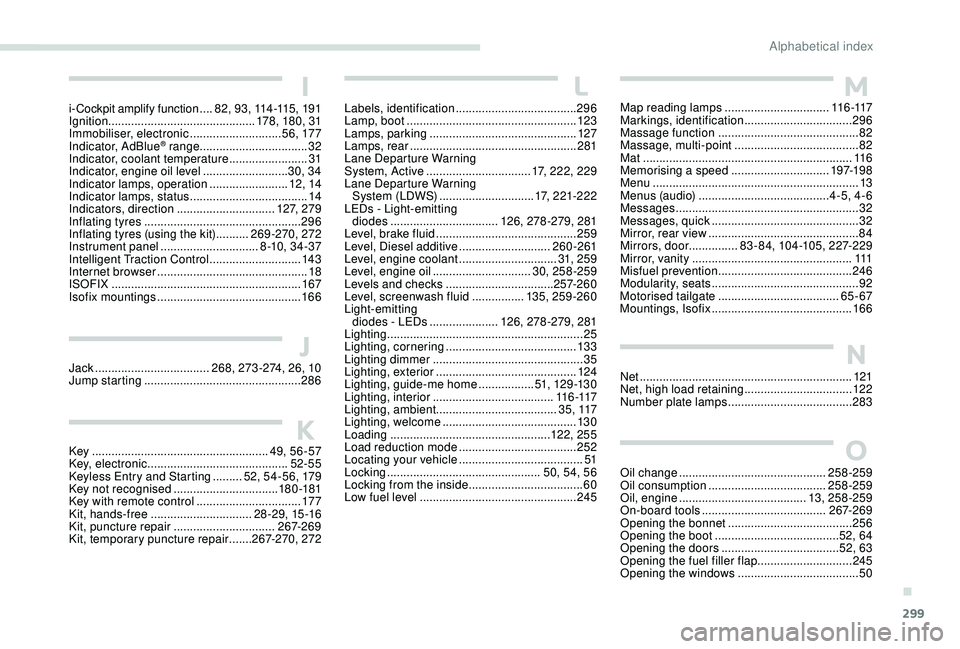
299
Key ...................................................... 49, 56-57
Key, electronic ........................................... 52-55
Keyless Entry and Starting
.........52
, 54-56, 179
Key not recognised
................................ 18
0 -181
Key with remote control
................................17
7
Kit, hands-free
............................... 2
8-29, 15 -16
Kit, puncture repair
............................... 2
67-269
Kit, temporary puncture repair
.......
267-270, 272 Map reading lamps
................................
11
6 -117
Markings, identification
.................................
296
Massage function ...........................................
82
Massage, multi-point
......................................
82
Mat
................................................................
11 6
Memorising a speed
..............................
19
7-198
Menu
...............................................................
13
Menus (audio)
........................................
4-5, 4-6
Messages
........................................................
32
Messages, quick
............................................. 3
2
Mirror, rear view ..............................................
84
Mirrors, door ...............83-84, 104 -105, 227-229
Mirror, vanity
.................................................
111
Misfuel prevention
.........................................
246
Modularity, seats
.............................................
92
Motorised tailgate
..................................... 6
5 - 67
Mountings, Isofix
...........................................
166K
J
LM
Labels, identification ..................................... 296
Lamp, boot .................................................... 123
Lamps, parking
............................................. 127
Lamps, rear
................................................... 281
Lane Departure Warning
System, Active
................................ 17, 222, 229
Lane Departure Warning System (LDWS)
............................. 17, 221-222
LEDs - Light-emitting diodes
................................. 126, 278-279, 281
Level, brake fluid
........................................... 259
Level, Diesel additive
............................260-261
Level, engine coolant
..............................31, 259
Level, engine oil
.............................. 30, 258-259
Levels and checks
..............................
...257-2 6 0
Level, screenwash fluid
................13
5, 259-260
Light-emitting diodes - LEDs
.....................126, 278-279, 281
Lighting
............................................................ 25
Lighting, cornering
........................................ 13 3
Lighting dimmer
.............................................. 35
Lighting, exterior
........................................... 124
Lighting, guide-me home
.................51, 12 9 -13 0
Lighting, interior
...............................
......11 6 -117
Lighting, ambient ..................................... 35, 117
Lighting, welcome
......................................... 13 0
Loading
................................................. 12 2, 255
Load reduction mode
.................................... 252
Locating your vehicle
...................................... 51
Locking
...............................
................50, 54, 56
Locking from the inside
...................................60
Low fuel level
................................................ 24
5
Jack
...............................
.... 268, 273-274, 26, 10
Jump starting
................................................ 286
I
i-Cockpit amplify function ....82, 93, 114 -115 , 191
Ignition ................ ............................. 178 , 18 0, 31
Immobiliser, electronic
............................56, 17 7
Indicator, AdBlue
® range ................................. 32
Indicator, coolant temperature ........................ 31
Indicator, engine oil level
.......................... 30, 34
Indicator lamps, operation
........................ 12
, 14
Indicator lamps, status
.................................... 14
I
ndicators, direction
.............................. 1 2 7, 279
Inflating tyres
................................................ 296
Inflating tyres (using the kit)
.......... 2
69-270, 272
Instrument panel
.............................. 8 -10, 34-37
Intelligent Traction Control
............................ 143
Internet browser
.............................................. 18
I
SOFIX
.......................................................... 167
Isofix mountings
............................................ 166
N
Net ................................................................. 121
Net, high load retaining .................................12 2
Number plate lamps
...................................... 283
O
Oil change ............................................. 25 8-259
Oil consumption .................................... 258-259
Oil, engine
....................................... 13, 258-259
On-board tools
...................................... 267-269
Opening the bonnet
...................................... 256
Opening the boot
...................................... 52, 64
Opening the doors
.................................... 52, 63
Opening the fuel filler flap
.............................245
Opening the windows
..................................... 50
.
Alphabetical index